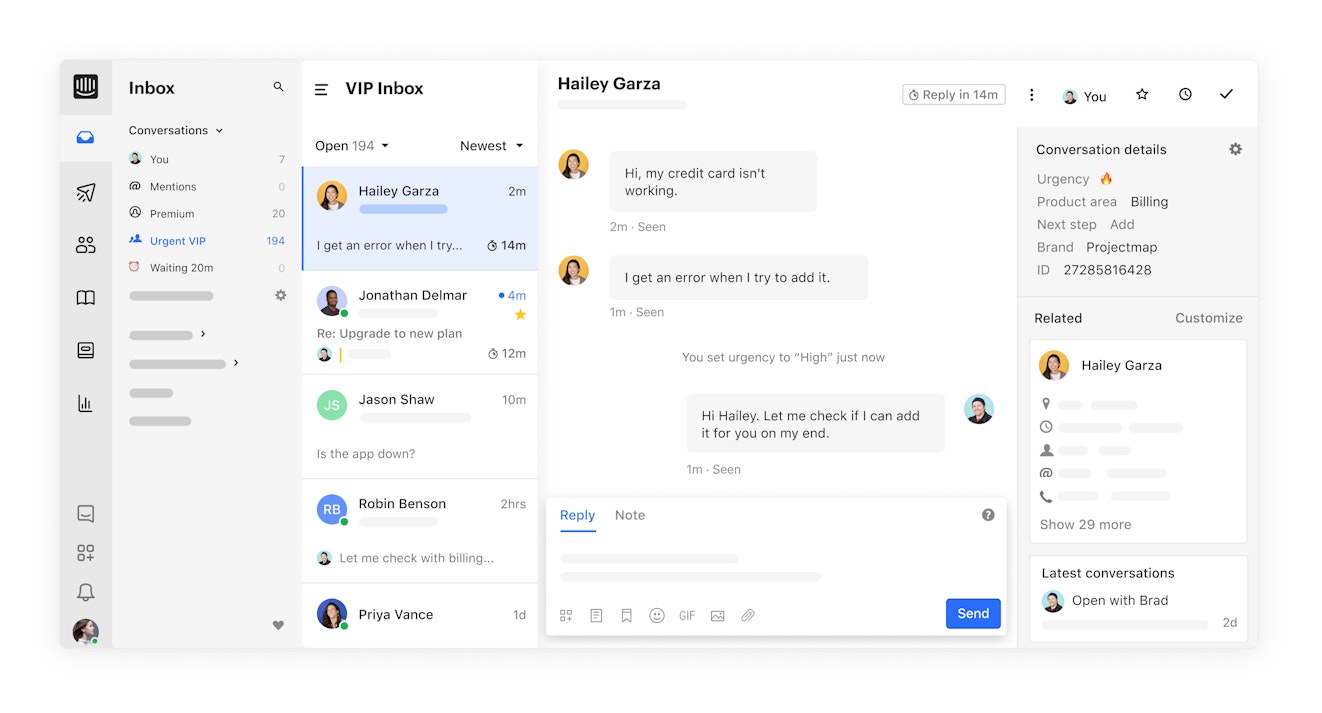When it comes to email, many people fall into one of two camps: those who spend part of each day deleting advertisements, unsubscribing from newsletters, and filtering down their inboxes to what’s important, and those who avoid their email entirely.
In fact, according to HubSpot, “40% of consumers say they have at least 50 unread emails in their inboxes.”
It’s not so much that customers don’t want to hear from brands they buy from, but most communications seem woefully generic — like an entire inbox full of email that was meant for someone else.
According to Salesforce’s State of the Connected Customer report, “88% of customers say the experience a company provides is as important as its product or services.” This means that your business’s customer communications need to be streamlined and personalized to gain your customers’ loyalty — and a spot in their inboxes.
Luckily, many customer communication tools are available to help your business create more personalized experiences for your customers.
The different types of customer communication tools
Though there are tools that cover multiple customer communication use cases, chances are, your business will have to invest in more than one tool to create a truly exceptional experience for your customers. So the first step in finding the right option for your company is to understand what the different types of customer communication tools are and what they're best for:
Help desk software: Help desk software serves as a central point to manage, respond to, and track customer conversations from a variety of channels. It’s a tool most commonly used by customer support teams, but other teams like sales or account management may utilize it, too.
Live chat software: Live chat offers the immediacy of phone support, but it allows agents to take multiple conversations at once, making it a bit more malleable and less costly. Live chat can also help boost sales for your company. In fact, one study found customers who utilized live chat actually spent 60% more on average.
Knowledge base software: Customers want options to help themselves, which is why one of the best customer communications tools any team can invest in is knowledge base software. Knowledge base software is used to build and manage a help center where customers can search for and find their own answers.
Call center software: Call center software is designed to help manage customer conversations happening over the phone. It’s most commonly used by sales and support teams. With it, you’re able to do things like route incoming calls, add notes to conversations, and track team performance.
Email marketing software: Email marketing software lets you do one-to-many communication effectively and efficiently. As the name suggests, marketing teams are the ones who tend to use these tools most often for things like product launches or to send out newsletters.
CRM software: Customer relationship management (CRM) software lets businesses manage and track customer interactions. It’s most commonly associated with sales as a tool to track different deals and customers, but there are some customer success applications for it, too.
Survey software: Surveys can help you get invaluable insights from customers that may not be easily collected otherwise. One of the most common uses is to measure satisfaction — either on a specific interaction or a specific product or service.
The benefits of using customer communication tools
While it’s true that you might be able to manage your company’s communications without using a dedicated tool, there are a lot of benefits to moving them into a single system.
Better customer experience
Customer communication tools make creating and delivering customer-centric experiences easier. They help you:
Minimize confusion: When sales, marketing, and support teams have full visibility of all messaging customers receive, it keeps everyone on the same page, aids in creating a cohesive communications strategy, and contributes to a unified brand voice.
Encourage contextual conversations: People don’t like to be treated like a number, but more than half of consumers feel that companies handle them that way. Customer communications tools provide customer data that helps your people-facing teams have more meaningful conversations with customers.
Aid in personalization: Customer communications software can help you reach out to your customers via the channels they prefer about the subjects they want to hear about, ensuring that your messaging is always relevant.
Better employee experience
Customer communications platforms also benefit employees. They can:
Simplify content creation: Many platforms come with pre-made templates for emails, contracts, and invoices, making it easy for anyone to deliver professional messaging to customers. Other client communication tools can optimize content for different devices, ensuring that what you send your customers is always correctly formatted.
Centralize client information: Instead of switching back and forth between things like email accounts, file sharing services, and digital document applications, customer communication platforms keep everything relating to a customer in one place.
Ease workloads: Personalized messaging can be difficult to scale without adding headcount. Customer communication tools help automate some tasks, improving efficiency and reducing stress on your team.
Better insights
Customer communication solutions are also useful for helping companies gain insights into their customers, product, and brand through analytics. Reporting based on the data you get from your customer communication tool can tell you more about your customers’:
Demographics: Who your customers are and where they live.
Preferences: What devices your customers use to view your content, their favorite channels, and what topics interest them the most.
Behavior: What communications receive the most engagement and when your customers typically interact with them.
Sentiment: What your customers think about your product or services and your brand in general.
Key features to look for in customer communication tools
Depending on your business and the communication channels your customers prefer, the features you’ll want your customer communication platform to have will vary. However, there are a few core features that most options should have:
Shared workspace: Look for software that promotes collaboration and avoids siloing information in personal inboxes or individual accounts.
Inbound and outbound channels: While some platforms only focus on outbound communications, choosing a tool that also supports inbound requests will keep you organized by creating a centralized hub for all customer interactions.
Accessible content creation tools: Choose a platform that simplifies content creation by offering templates, drag-and-drop interfaces, and WYSIWYG text editors.
Automation capabilities: Ensure that any tool you consider can create automatic workflows for repetitive tasks.
Audience segmentation: Select an option that can help keep customer communications personalized, relevant, and timely by segmenting your customer lists.
Integrations: Choose a platform that can integrate with your company’s current software (CRM, ecommerce software, etc.).
Reporting and analytics: Look for robust reporting abilities that can measure engagement and help you better understand the effectiveness of your messaging.
The 7 best customer communication tools
To help you find the option that will best meet your business’s needs, we’ve compiled a list of seven exceptional customer communication tools that can help you manage everything from support requests to customer invoicing to proactive marketing campaigns.
1. Help Scout – Best for growing businesses
Help Scout is a customer communication platform that helps growing teams build better customer relationships. Designed to delight, Help Scout can help your team manage communications across channels like email and live chat while also providing tools for proactive messaging and self-service support.
Shared inbox
Help Scout’s core product is centered around its shared inbox — a hub for all of your team’s incoming and outgoing customer communications. Easily manage email as a team using collaborative features like conversation assignments and statuses, collision detection, saved replies, and private notes.
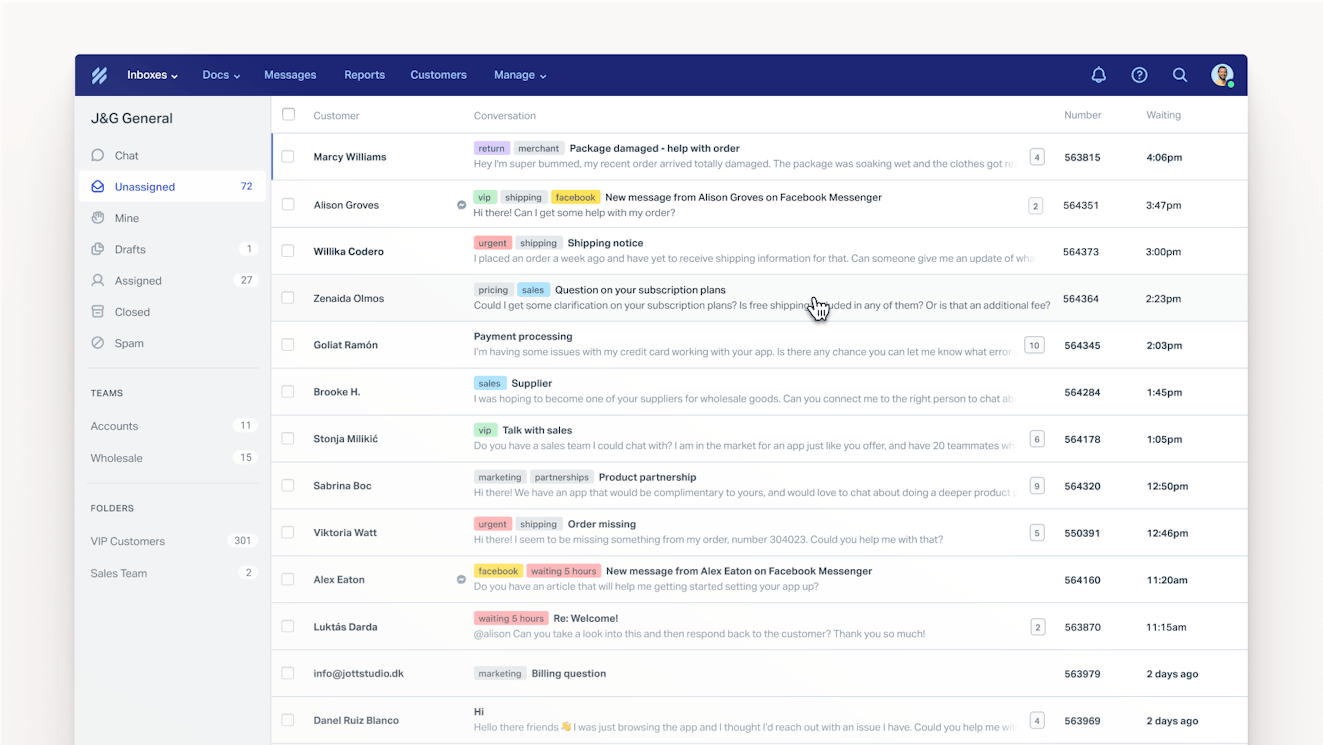
The customer information sidebar helps you better understand your customers. See key information like contact details and conversation history, then integrate other systems in your tech stack for a comprehensive view of the customer journey.
The platform also makes automating tasks to increase productivity easy using condition-based workflows. Assign conversations, add tags, and escalate cases to get customers the information they need quickly.
Live chat
Add a Beacon — Help Scout’s web widget — to any web page, or embed it in your app to add live chat to your customer experience.
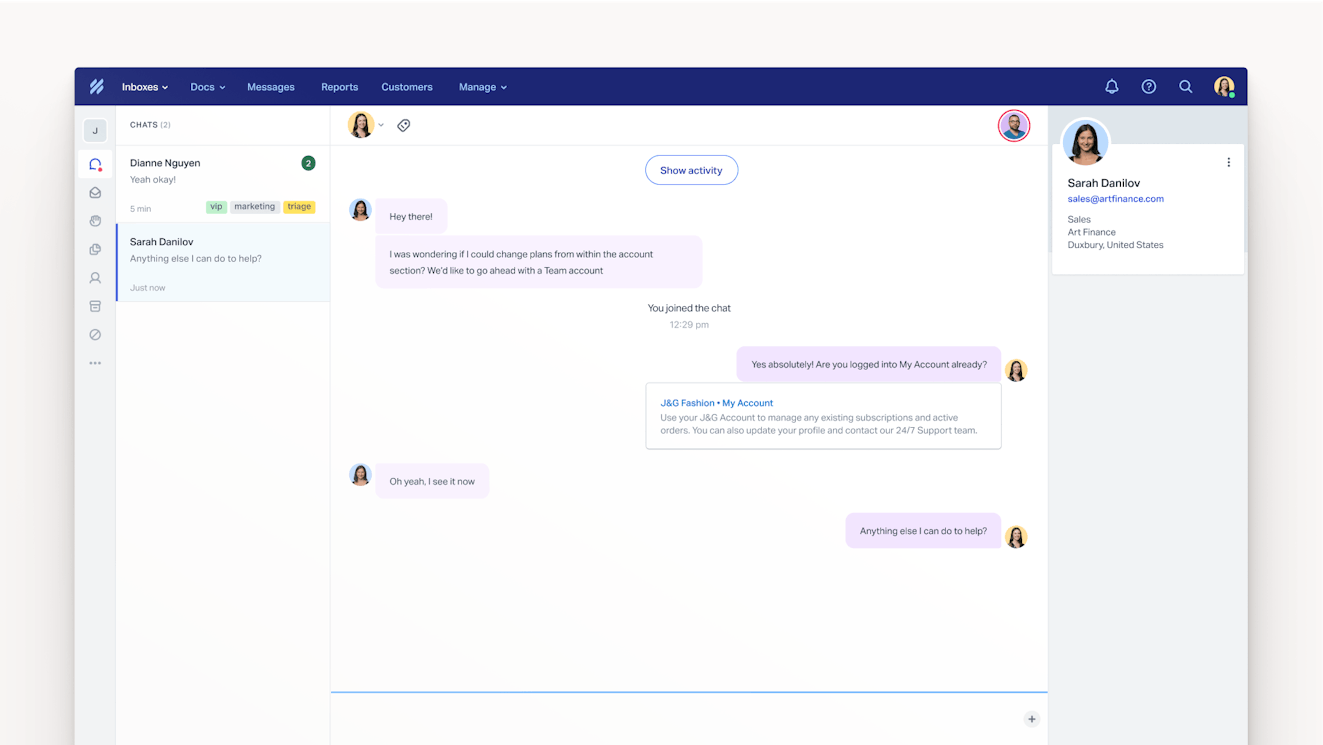
Live chat is also managed within the platform’s universal inbox, allowing teams to use helpful features like customer profiles and chat-formatted saved replies to answer customer questions quickly. If a conversation can’t be resolved in real time, agents can transition to email for a seamless handling experience.
Docs
Docs, Help Scout’s knowledge management solution, lets you create a customizable help center for your customers — no coding necessary.
Author articles using a simple WYSIWYG editor, add media like videos and images, and organize your documentation using keywords and a simple hierarchy consisting of collections, categories, and articles.
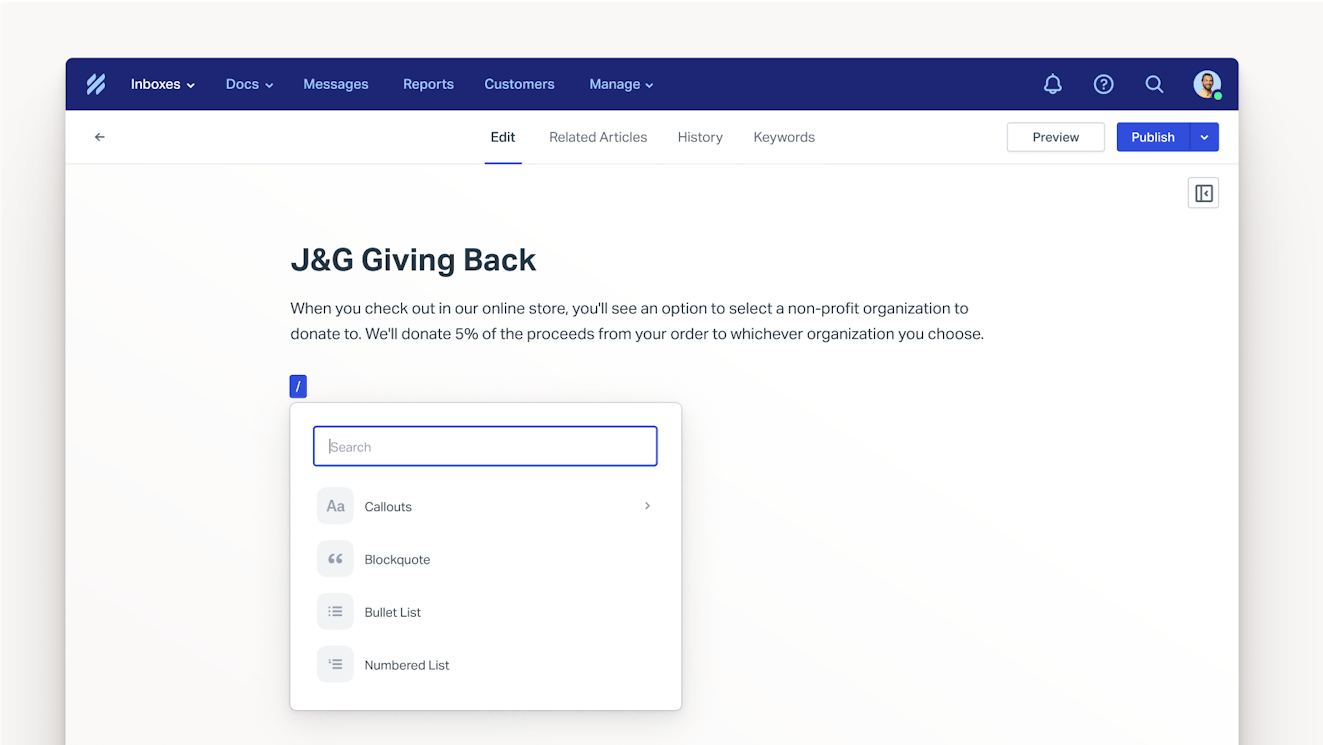
You can publish Docs articles for internal or external audiences, and customers can access your content via a Docs site or a Beacon. In addition, agents can search for and reference documentation within a conversation window, helping them find the information necessary to deliver excellent support.
AI tools
Help Scout also includes AI tools to help make your team's life a little easier. Use AI Summarize to get a quick summary of a long conversation. AI Assist can help with your copy's spelling, grammar, length and tone, and even translate it into another language. AI Drafts automatically generates replies to incoming customer emails that are based on your account's conversation history and knowledge base data. Simply review, edit if necessary, and hit send.
Proactive messaging and microsurveys
Beyond serving up live chat and knowledge base articles, Beacons can also engage your customers proactively. Help Scout’s messaging feature can surface targeted messages to your users using standard, modal, or banner-style displays.
Tell customers about service changes, promote an upcoming event, or surface a helpful Docs article at a sticky moment.
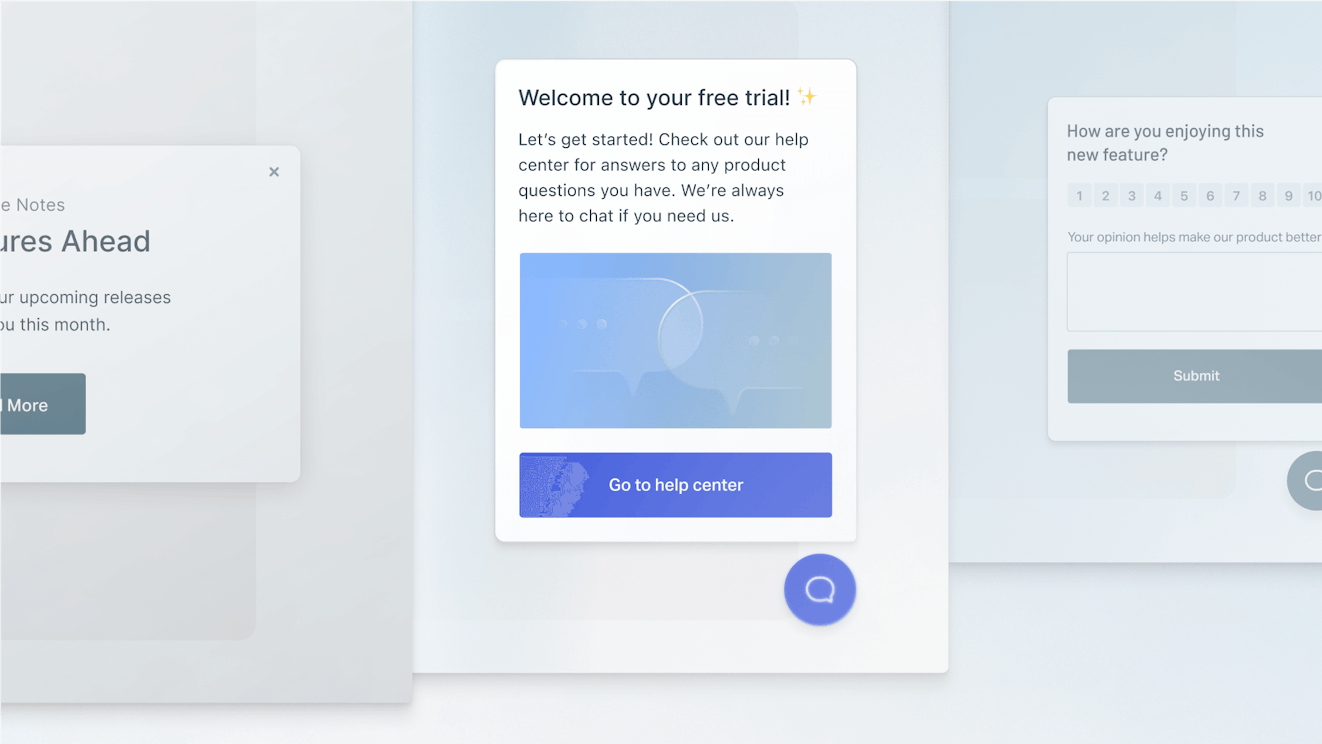
Help Scout’s Beacon can also help gauge customer sentiment with microsurveys — short customer touchpoints placed directly within your customer experience. Like regular messages, microsurveys are targeted to reach the right customers at the right time. Choose from six survey types, including NPS, multiple choice, and a simple thumbs up or down.
Reports
The best decisions are based on data, so Help Scout offers reporting dashboards for all of its tools. Discover which channels your customers prefer, how many conversations your team is fielding each day, which Docs articles are most popular, and which proactive messaging campaigns receive the most engagement.
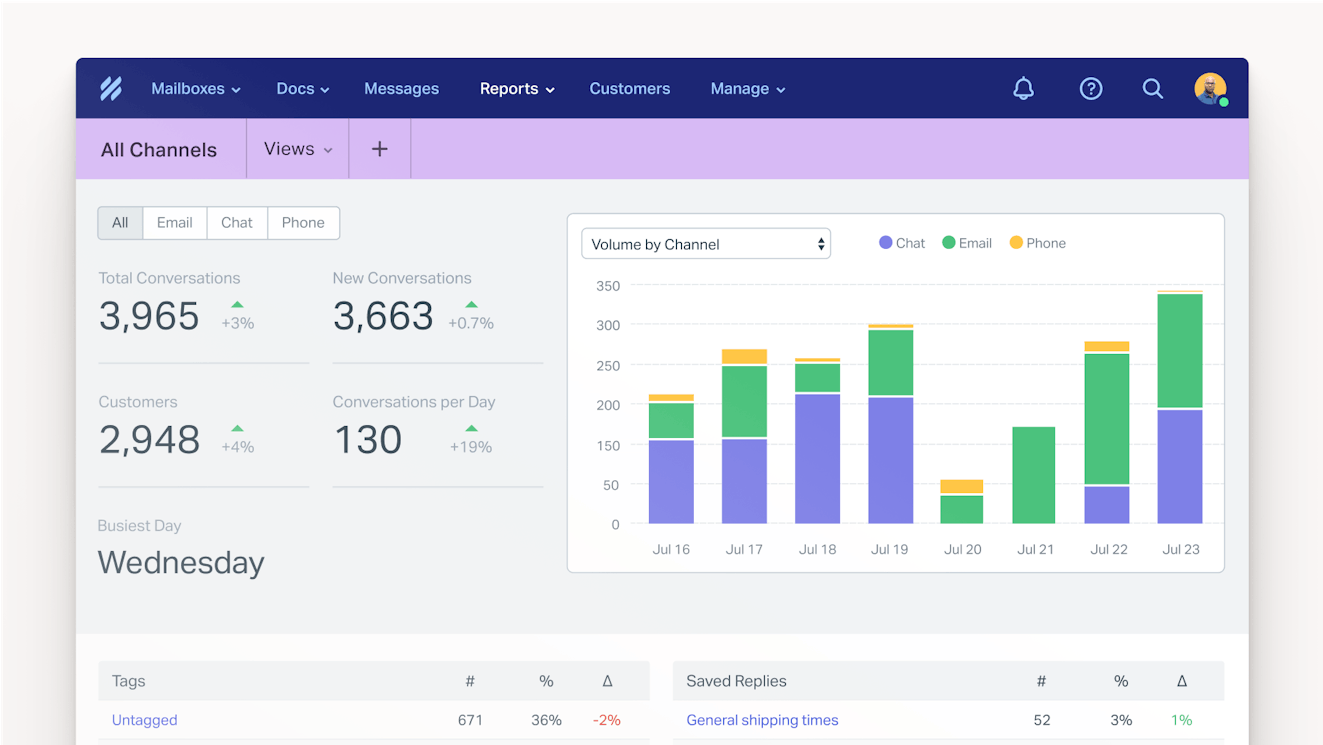
Integrations
Help Scout integrates with many popular applications such as ecommerce platforms, CRMs, analytics platforms, and marketing applications. You can also connect systems using online automation tools like Zapier or build your own using the Help Scout API.
Price: Free plan available. Paid plans start at $50 per month.
2. HoneyBook – Best customer communications tool for freelancers
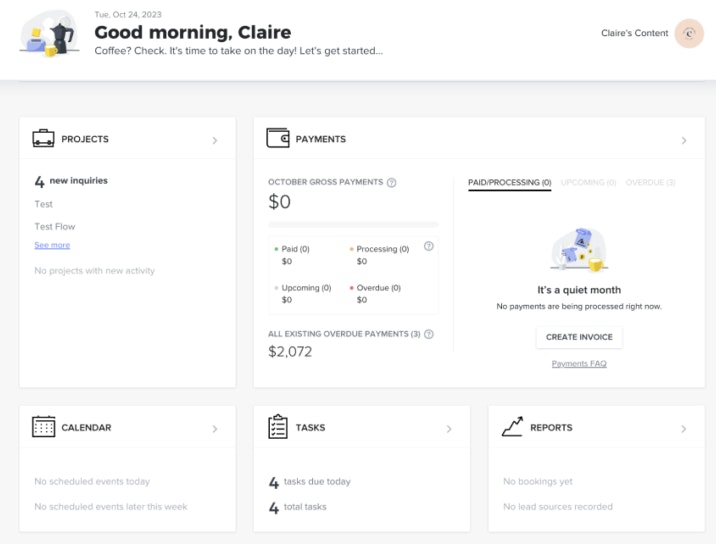
HoneyBook began as a platform where wedding photographers could share photos and digital media with their clients. Today, the product has evolved into a full-service client management solution ideal for freelancers, creatives, and small businesses.
The software allows you to manage all customer communications from within one tool. Here are a few things you can do with HoneyBook:
Integrate your business email account and calendar with HoneyBook, making it easy to read and reply to emails and schedule appointments without needing to switch between windows.
Send professional invoices and accept secure payments.
Create, send, and sign contracts using pre-made templates or text of your own.
Automate tasks like feedback requests and email responses, or create reminders for your team.
The HoneyBook platform is quite affordable. You can pay monthly or annually, and all plans come with unlimited clients and projects. If you’re a freelancer or small business looking for a better way to engage with your clients, HoneyBook is a good option.
Price: Free trial available. Plans start at $29 per month.
3. Zendesk – Best for variety of integrations with other tools

Zendesk is an omnichannel solution for customer communications management. No matter which channels your customers prefer — email, chat, social, text, voice, or self-service — you can manage them using Zendesk.
The platform is widely known in the customer support space, and one of the benefits of its popularity is that many software companies have created custom apps for Zendesk’s marketplace. There are also developers who specialize in Zendesk integrations that can help you build custom solutions. Integrating your CCM platform with other systems your business uses can give your team additional context as they work through customer support queues and interact with potential leads.
While Zendesk is an excellent choice for some teams, it does have shortcomings. The platform can be tricky to implement and maintain, and some integrations require additional development work. This means that Zendesk is best used by those with in-house development resources or the budget to hire out if extra work is needed.
Price: Free trial available. Plans start at $19/user per month.
If Zendesk is close to but not exactly what you're looking for, find similar options in our list of the best Zendesk alternatives.
4. Moxo
Best customer communications management software for those interested in offering a mobile experience.
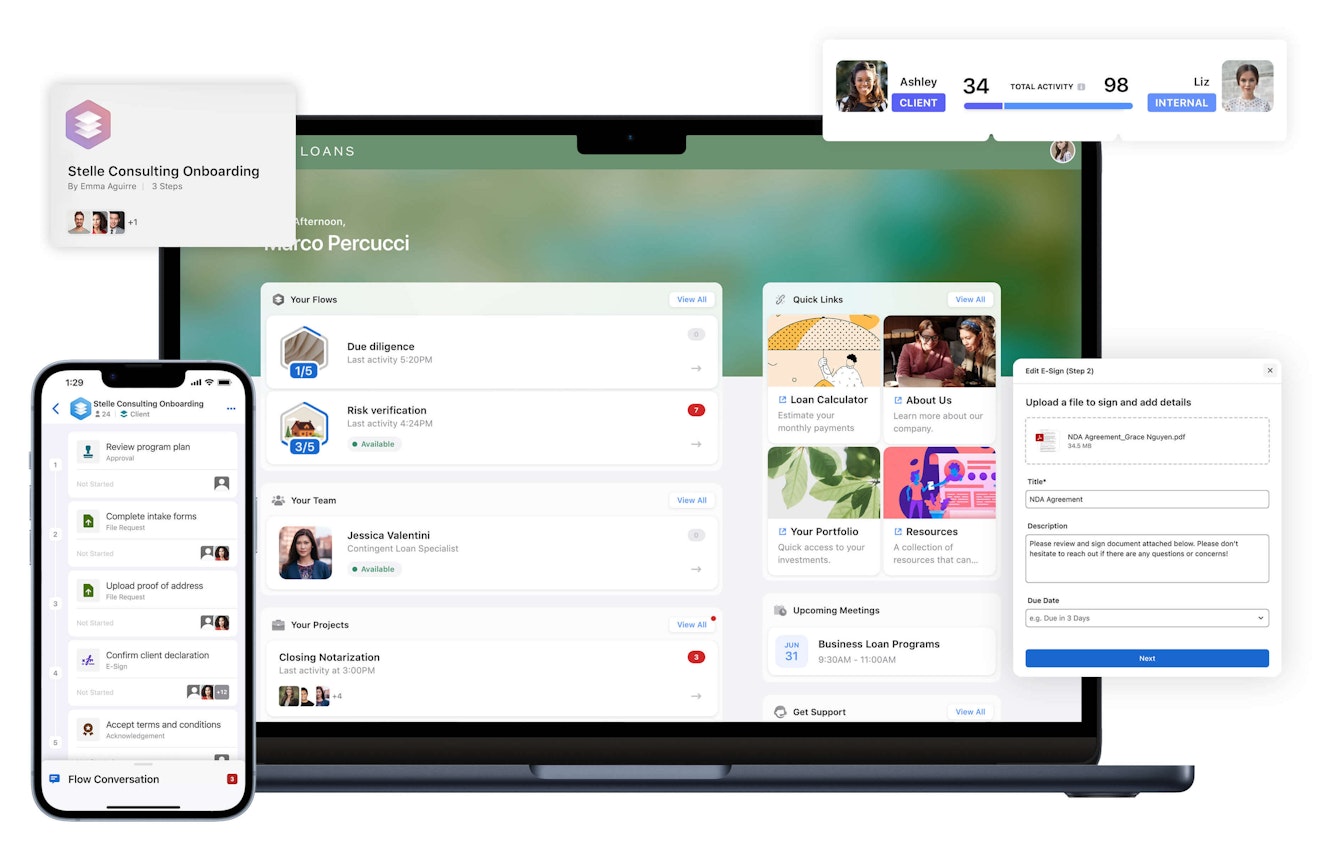
Moxo is a client communication software platform similar to a product like HoneyBook in that it creates a centralized place for all client interactions. However, Moxo takes it a bit further, offering the ability to create client portals for your customers that can either be stand-alone or integrated into your existing website or mobile apps.
The Moxo platform allows you to communicate with customers via secure messaging, video meetings, and co-browsing. You can also schedule meetings, digitally annotate shared files, manage tasks, share important documents, and obtain digital signatures.
The best part about Moxo is that they offer private-labeled apps, making it a good choice for businesses that don’t have the development resources required to design, build, and maintain an app in-house.
Price: Contact Moxo for pricing.
5. Front – Best combined support and email marketing software

Much like Help Scout and Zendesk, Front is a communications platform that funnels communications from multiple channels — email, live chat, SMS, and social media — into a shared inbox. From there, features like email assignments, message templates, shared drafts, message comments, and guest users help your team swiftly work through your communications queue as a team.
Front is also great for managing your personal email. While most shared inboxes and help desks focus on team email, Front lets each user bring their personal email address into the tool as well. Not only can employees save time by not needing to flip back and forth between applications, but they also can use Front’s rules feature to automate actions within their personal inboxes.
Another interesting feature of the Front platform is its email campaign tool, Sequences. Sequences let you schedule and send out multi-stage email campaigns to a list of recipients. If your company isn’t quite ready for a stand-alone email marketing solution, Sequences might be a good stopgap.
Price: Free trial available. Plans start at $19/user per month.
6. Intercom – Best customer communication tool for sales teams
For teams looking for a sales-focused communications platform, Intercom might fit the bill. The company is well known by sales and marketing pros as a powerful tool for converting leads and proactively communicating with customers.
Intercom’s core feature is its Messenger tool. Like with Help Scout’s Beacon, you can place a Messenger widget on any webpage or within your app to facilitate live and async chat conversations, surface proactive messaging, or display knowledge base articles.
In addition to chat, the platform has a shared inbox where teams can collaboratively manage email and a ticketing system for tracking customer issues. Companies can also create product walkthroughs and to-do lists to aid in product onboarding.
Price: Free trial available. Plans start at $29/seat per month.
7. Podium – Best customer communication tool for local businesses
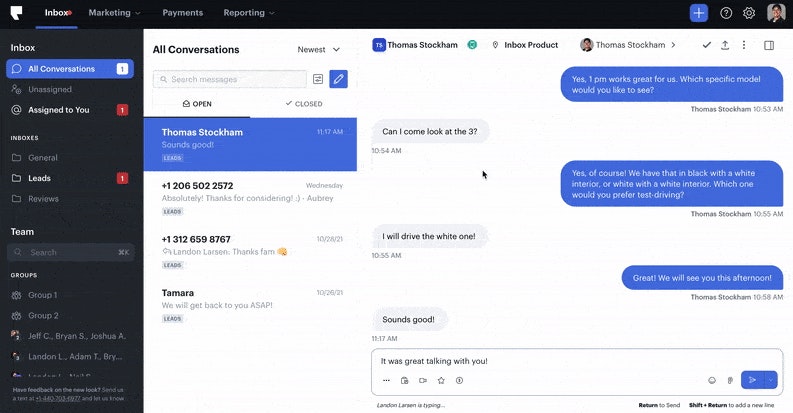
Podium is a customer communication management platform designed for local businesses. While some features may be similar to other tools on this list — shared inbox, live chat, customer data collection, and payment processing — others are targeted to the specific needs of a brick-and-mortar company.
It’s hard to overstate the importance of Google and Facebook business reviews for local businesses. Podium gets that and offers a review management feature that simplifies the process of responding to reviews. You can solicit and respond to reviews directly from the platform, and team members can leave internal notes to ensure that everyone is kept in the loop while they address customer concerns.
Podium also offers several tools to promote sales and marketing efforts. You can launch personalized SMS campaigns in minutes, you can place a live chat widget on your website to help capture leads, and the software can automate simple tasks like requesting a review or referral.
Price: Contact Podium for pricing.
Choosing the right customer communication tool for your business
Effective communication with customers is at the center of almost every successful business, and specialized tools can help make those interactions easier and more impactful. Whether you’re looking to improve your customer support, tell users about a new feature, or help customers help themselves, there’s a tool to help you do it better.
If you think customer communications software might help your business stay at the top of your customers’ inboxes, consider signing up for a demo or free trial for one of the tools above. This will allow your team to see the software in action, have the opportunity to ask any questions that come up during the trial, and ultimately determine which platform is right for you.




